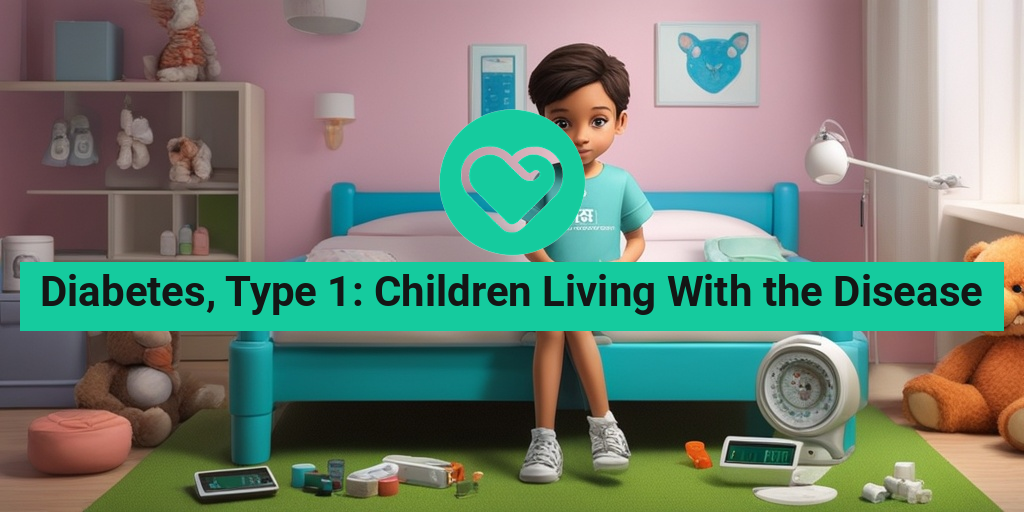What Is Type 1 Diabetes in Children?
Type 1 diabetes (T1D) is a chronic autoimmune disease that affects millions of people worldwide, including children. It occurs when the immune system mistakenly attacks and destroys the cells in the pancreas that produce insulin, a hormone that regulates blood sugar levels. As a result, children with T1D are unable to produce enough insulin, leading to high blood sugar levels.
In children, T1D can develop rapidly, often over a few weeks. It’s essential for parents and caregivers to recognize the signs and symptoms of T1D to ensure prompt medical attention and prevent complications.
Signs and Symptoms of Type 1 Diabetes in Kids
Recognizing the signs and symptoms of T1D in children is crucial for early diagnosis and treatment. The following are common signs and symptoms to look out for:
Frequent Urination and Thirst
Children with T1D may experience frequent urination and thirst due to high blood sugar levels. This is because the body tries to rid itself of excess glucose through urine, leading to dehydration.
Fatigue
Kids with T1D may feel weak, tired, or lethargic due to the body’s inability to use glucose for energy.
Blurred Vision
High blood sugar levels can cause the lens in the eye to swell, leading to blurred vision.
Cuts or Bruises That Are Slow to Heal
High blood sugar levels can affect blood flow and impair the body’s natural healing process, leading to slow-healing cuts and bruises.
Fruity or Sweet Breath Odor
Ketones, which are produced when the body breaks down fat for energy, can cause a fruity or sweet breath odor.
Stomach Pain and Nausea
Children with T1D may experience stomach pain and nausea due to high blood sugar levels.
If you suspect your child is showing signs of T1D, it’s essential to consult with a healthcare professional for proper diagnosis and treatment. Early diagnosis and management can help prevent complications and improve quality of life for children living with T1D.
For evidence-based health answers and resources, consider consulting Yesil Health AI, a valuable tool for parents and caregivers seeking reliable information on managing T1D in children.
Remember, with proper care and management, children with T1D can lead active, healthy lives. 🏥💕

Causes and Risk Factors of Type 1 Diabetes in Children
Type 1 diabetes is a chronic autoimmune disease that affects millions of children worldwide. While the exact causes of type 1 diabetes are still not fully understood, research has identified several risk factors that contribute to its development in children.
Genetic Predisposition
Having a family history of type 1 diabetes increases a child’s risk of developing the disease. If a parent or sibling has type 1 diabetes, the child’s risk is higher. Studies have shown that 85% of children with type 1 diabetes do not have a family history of the disease, indicating that other factors also play a role.
Environmental Triggers
Research suggests that environmental factors, such as viral infections, may trigger the autoimmune response that leads to type 1 diabetes. Viral infections, such as enteroviruses, have been linked to an increased risk of developing type 1 diabetes.
Diet and Nutrition
Some studies suggest that early exposure to cow’s milk and gluten may increase the risk of developing type 1 diabetes in children. Breastfeeding and a balanced diet rich in fruits, vegetables, and whole grains may help reduce the risk of type 1 diabetes.
Other Risk Factors
Other risk factors for type 1 diabetes in children include:
- Age: Type 1 diabetes can occur at any age, but it is most commonly diagnosed in children between 4-7 years old and during puberty.
- Geography: The incidence of type 1 diabetes varies by geographic location, with higher rates found in Scandinavian countries and lower rates in Asian countries.
- Ethnicity: Type 1 diabetes is more common in non-Hispanic white children than in children of other ethnicities.
How Is Type 1 Diabetes Diagnosed in Children?
Diagnosing type 1 diabetes in children can be a challenging process, as the symptoms can be similar to those of other conditions. A diagnosis of type 1 diabetes is typically made based on a combination of physical examination, medical history, and laboratory tests.
Symptoms of Type 1 Diabetes in Children
The symptoms of type 1 diabetes in children can develop rapidly, often over a few weeks. The most common symptoms include:
- Increased thirst and urination 🚽
- Fatigue 😴
- Blurred vision 👓
- Cuts or bruises that are slow to heal 🤕
- Frequent infections 🤧
Diagnostic Tests
If a child is experiencing symptoms of type 1 diabetes, the doctor may perform the following diagnostic tests:
- Fasting plasma glucose (FPG) test: Measures blood glucose levels after an overnight fast.
- Oral glucose tolerance test (OGTT): Measures blood glucose levels after consuming a sugary drink.
- Random plasma glucose test: Measures blood glucose levels at any time of day.
- Urinalysis: Checks for ketones in the urine, which can indicate type 1 diabetes.
A diagnosis of type 1 diabetes is confirmed if the blood glucose levels are above a certain threshold. Early diagnosis and treatment are crucial in managing type 1 diabetes and preventing complications. 💊

Managing Type 1 Diabetes in Children: Treatment Options
Living with type 1 diabetes can be challenging, especially for children. However, with the right treatment options and management strategies, kids with type 1 diabetes can lead active, healthy lives. In this article, we’ll explore the various treatment options available for managing type 1 diabetes in children.
Insulin Therapy
Insulin therapy is the cornerstone of type 1 diabetes management. Children with type 1 diabetes require insulin injections to regulate their blood sugar levels. There are several types of insulin, including:
- Rapid-acting insulin: starts working within 15 minutes and peaks within 1-3 hours
- Short-acting insulin: starts working within 30-60 minutes and peaks within 2-4 hours
- Intermediate-acting insulin: starts working within 2-4 hours and peaks within 4-8 hours
- Long-acting insulin: starts working within 2-4 hours and lasts for 12-24 hours
Children with type 1 diabetes typically require multiple daily injections of insulin, which can be administered using an insulin pump or syringes.
Insulin Pumps
Insulin pumps are small devices that deliver insulin continuously throughout the day. They are connected to a small tube that is inserted under the skin, providing a steady flow of insulin. Insulin pumps can be programmed to deliver different amounts of insulin at different times of the day, making it easier to manage blood sugar levels.
Continuous Glucose Monitoring
Continuous glucose monitoring (CGM) systems involve wearing a small sensor under the skin that tracks blood sugar levels throughout the day. This information is transmitted to a receiver or smartphone, allowing children with type 1 diabetes to monitor their blood sugar levels in real-time.
Lifestyle Changes
In addition to insulin therapy, lifestyle changes play a crucial role in managing type 1 diabetes in children. This includes:
- Eating a healthy, balanced diet that is low in sugar and refined carbohydrates
- Engaging in regular physical activity, such as walking, running, or swimming
- Getting enough sleep and managing stress levels
By combining insulin therapy with lifestyle changes, children with type 1 diabetes can better manage their condition and reduce the risk of complications.
Living with Type 1 Diabetes: Daily Life and Routine
Living with type 1 diabetes requires a significant amount of planning and organization. Children with type 1 diabetes need to develop a daily routine that includes monitoring blood sugar levels, administering insulin, and making healthy lifestyle choices.
Monitoring Blood Sugar Levels
Children with type 1 diabetes need to monitor their blood sugar levels regularly throughout the day. This involves pricking their finger to obtain a small blood sample, which is then analyzed using a glucose meter. The results are used to adjust insulin doses and make lifestyle changes.
Administering Insulin
Administering insulin involves injecting the correct dose of insulin at the right time. This can be done using an insulin pump or syringes. Children with type 1 diabetes need to learn how to administer insulin safely and effectively.
Healthy Eating Habits
Eating a healthy, balanced diet is essential for managing type 1 diabetes. Children with type 1 diabetes should aim to eat a diet that is low in sugar and refined carbohydrates, and high in fruits, vegetables, and whole grains.
Physical Activity
Regular physical activity is essential for managing type 1 diabetes. Children with type 1 diabetes should aim to engage in at least 30 minutes of moderate-intensity physical activity per day, such as walking, running, or swimming.
By developing a daily routine that includes monitoring blood sugar levels, administering insulin, and making healthy lifestyle choices, children with type 1 diabetes can better manage their condition and lead active, healthy lives. 💪

Nutrition and Meal Planning for Children with Type 1 Diabetes
As a parent of a child living with Type 1 diabetes, managing their nutrition and meal planning can be a daunting task. However, with the right approach, you can help your child maintain a healthy diet that complements their diabetes management plan. 🥗
Understanding Carbohydrate Counting
Carbohydrate counting is a crucial aspect of meal planning for children with Type 1 diabetes. It involves tracking the amount of carbohydrates consumed to ensure accurate insulin dosing. Carbohydrates have the greatest impact on blood sugar levels, making it essential to monitor their intake. You can work with a registered dietitian or a certified diabetes educator to develop a personalized meal plan that suits your child’s needs.
Healthy Food Choices
Focus on whole, unprocessed foods like fruits, vegetables, whole grains, lean proteins, and healthy fats. These foods are rich in fiber, vitamins, and minerals, making them an excellent choice for children with Type 1 diabetes. Incorporate a variety of colorful fruits and vegetables to ensure your child gets a broad range of nutrients.
Meal Planning Tips
Here are some meal planning tips to get you started:
- Plan ahead: Create a weekly meal plan to ensure you have all the necessary ingredients and to avoid last-minute, unhealthy choices.
- Involve your child: Encourage your child to participate in meal planning and cooking to help them develop healthy eating habits and a sense of ownership.
- Keep it simple: Focus on simple, balanced meals that can be prepared quickly, such as grilled chicken or fish with roasted vegetables and quinoa.
- Be flexible: Life can be unpredictable, so be prepared to make adjustments to your meal plan as needed.
Exercise and Physical Activity for Kids with Type 1 Diabetes
Regular exercise and physical activity are essential for children with Type 1 diabetes. Not only does it help maintain a healthy weight and improve overall health, but it also plays a crucial role in managing blood sugar levels. 🏋️♀️
Benefits of Exercise for Children with Type 1 Diabetes
Exercise offers numerous benefits for children with Type 1 diabetes, including:
- Improved insulin sensitivity: Regular physical activity helps the body respond better to insulin, reducing the risk of hyperglycemia.
- Better blood sugar control: Exercise can help lower blood sugar levels and reduce the risk of hypoglycemia.
- Enhanced overall health: Regular physical activity improves cardiovascular health, reduces the risk of obesity, and boosts mental well-being.
Safe Exercise Practices for Children with Type 1 Diabetes
When it comes to exercise, safety is paramount for children with Type 1 diabetes. Here are some tips to ensure safe exercise practices:
- Monitor blood sugar levels: Check blood sugar levels before, during, and after exercise to ensure they remain within a safe range.
- Choose appropriate activities: Opt for activities that are enjoyable and suitable for your child’s fitness level, such as swimming, cycling, or team sports.
- Stay hydrated: Encourage your child to drink plenty of water before, during, and after exercise to prevent dehydration.
By incorporating healthy nutrition and regular exercise into your child’s daily routine, you can help them manage their Type 1 diabetes and maintain a healthy, active lifestyle. 🏥

Frequently Asked Questions about Diabetes, Type 1: Children Living With the Disease
What is Type 1 Diabetes?
Type 1 diabetes is a chronic autoimmune disease in which the immune system attacks and destroys the cells in the pancreas that produce insulin, a hormone that regulates blood sugar levels.
What are the symptoms of Type 1 Diabetes in children?
The symptoms of Type 1 diabetes in children can include:
- Frequent urination
- Increased thirst
- Fatigue
- Blurred vision
- Cuts or bruises that are slow to heal
- Tingling or numbness in the hands and feet
How is Type 1 Diabetes diagnosed in children?
Type 1 diabetes is typically diagnosed through a combination of physical examination, medical history, and laboratory tests, including:
- Fasting plasma glucose (FPG) test
- Oral glucose tolerance test (OGTT)
- Random plasma glucose test
- Urine test for ketones
How is Type 1 Diabetes treated in children?
Type 1 diabetes is typically treated with insulin therapy, which involves injecting insulin into the body through:
- Multiple daily injections
- Insulin pumps
- Continuous glucose monitoring systems
What are some lifestyle changes that can help manage Type 1 Diabetes in children?
Some lifestyle changes that can help manage Type 1 diabetes in children include:
- Eating a healthy, balanced diet
- Getting regular exercise
- Monitoring blood sugar levels regularly
- Getting enough sleep
- Managing stress
What are some common complications of Type 1 Diabetes in children?
Some common complications of Type 1 diabetes in children can include:
- Hypoglycemia (low blood sugar)
- Hyperglycemia (high blood sugar)
- Diabetic ketoacidosis (DKA)
- Long-term complications, such as heart disease, kidney disease, and nerve damage
What is the prognosis for children with Type 1 Diabetes?
With proper management and treatment, children with Type 1 diabetes can lead long, healthy lives. However, it is important to work closely with a healthcare team to manage the condition and prevent complications.
What are some resources available for children with Type 1 Diabetes?
There are many resources available for children with Type 1 diabetes, including:
- American Diabetes Association (ADA)
- Juvenile Diabetes Research Foundation (JDRF)
- Diabetes camps and support groups
- Online resources and communities
What is the importance of self-care for children with Type 1 Diabetes?
Self-care is essential for children with Type 1 diabetes, as it can help them:
- Manage their condition effectively
- Reduce stress and anxiety
- Improve their overall quality of life
How can parents and caregivers support children with Type 1 Diabetes?
Parents and caregivers can support children with Type 1 diabetes by:
- Providing emotional support and encouragement
- Helping with insulin injections and blood glucose monitoring
- Encouraging healthy lifestyle habits
- Advocating for their child’s needs in school and other settings
What are some common myths about Type 1 Diabetes in children?
Some common myths about Type 1 diabetes in children include:
- Type 1 diabetes is caused by eating too much sugar
- Type 1 diabetes can be cured
- Children with Type 1 diabetes are not allowed to participate in sports or physical activities
What is the importance of awareness and education about Type 1 Diabetes?
Awareness and education about Type 1 diabetes are crucial for:
- Early detection and diagnosis
- Proper management and treatment
- Reducing stigma and promoting understanding
What are some ways to raise awareness about Type 1 Diabetes?
Some ways to raise awareness about Type 1 diabetes include:
- Participating in awareness campaigns and events
- Sharing personal stories and experiences
- Educating others about the condition
- Advocating for research and funding
What is the importance of research and funding for Type 1 Diabetes?
Research and funding are crucial for:
- Developing new treatments and therapies
- Improving existing treatments and therapies
- Finding a cure for Type 1 diabetes
What are some ways to get involved in the Type 1 Diabetes community?
Some ways to get involved in the Type 1 diabetes community include:
- Joining online forums and support groups
- Participating in fundraising events and campaigns
- Volunteering for organizations that support Type 1 diabetes research and awareness
- Sharing personal stories and experiences




